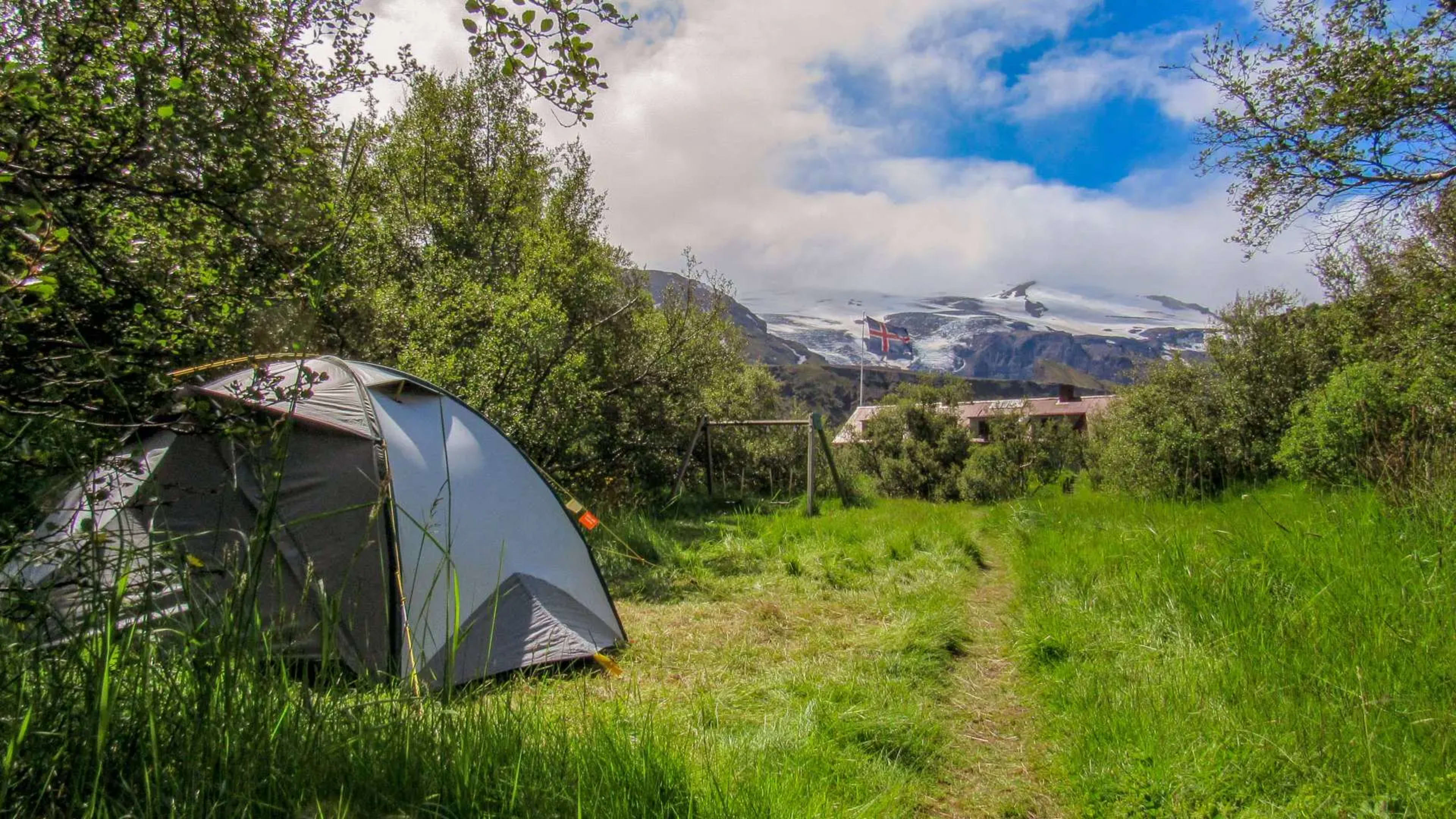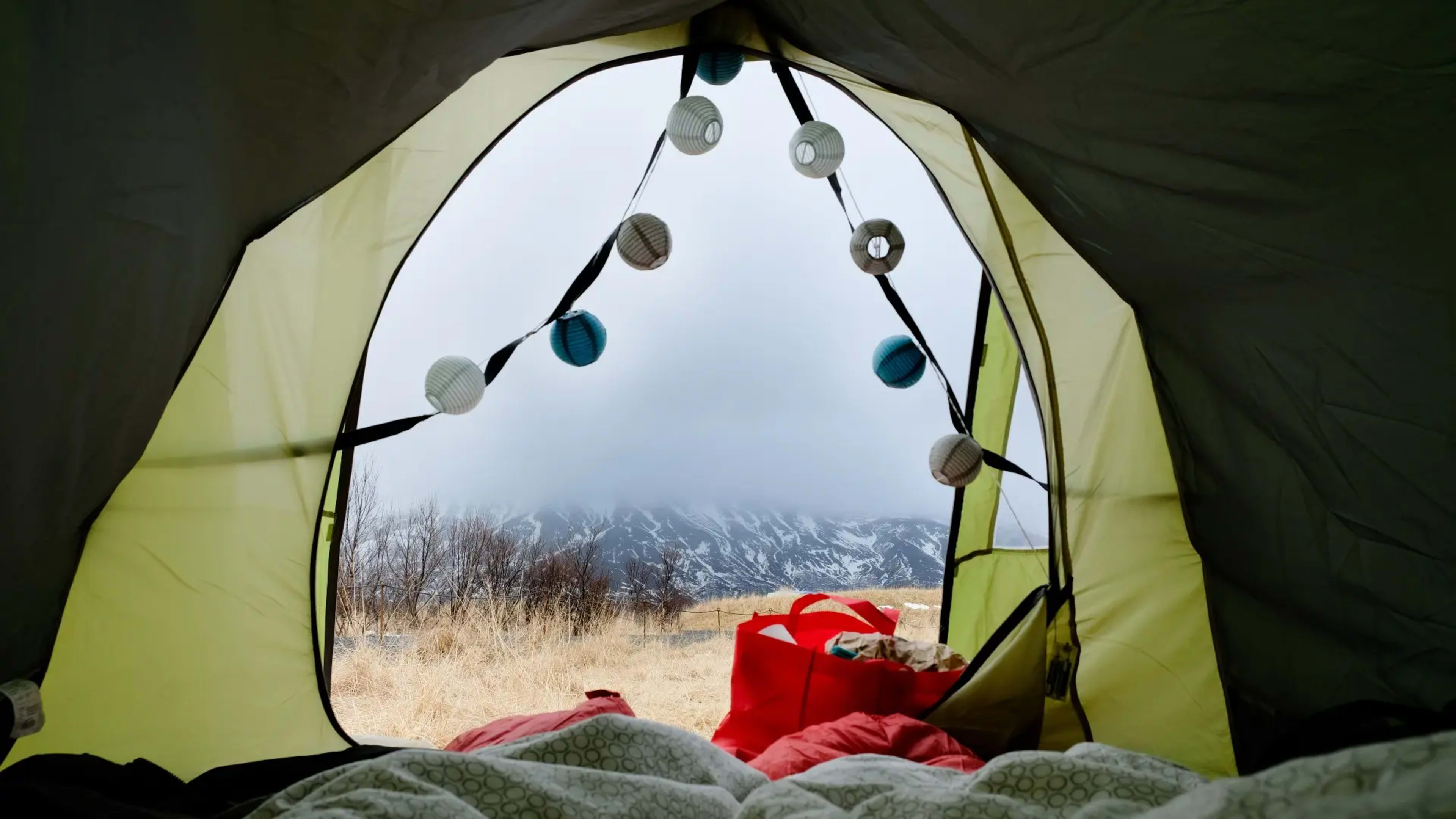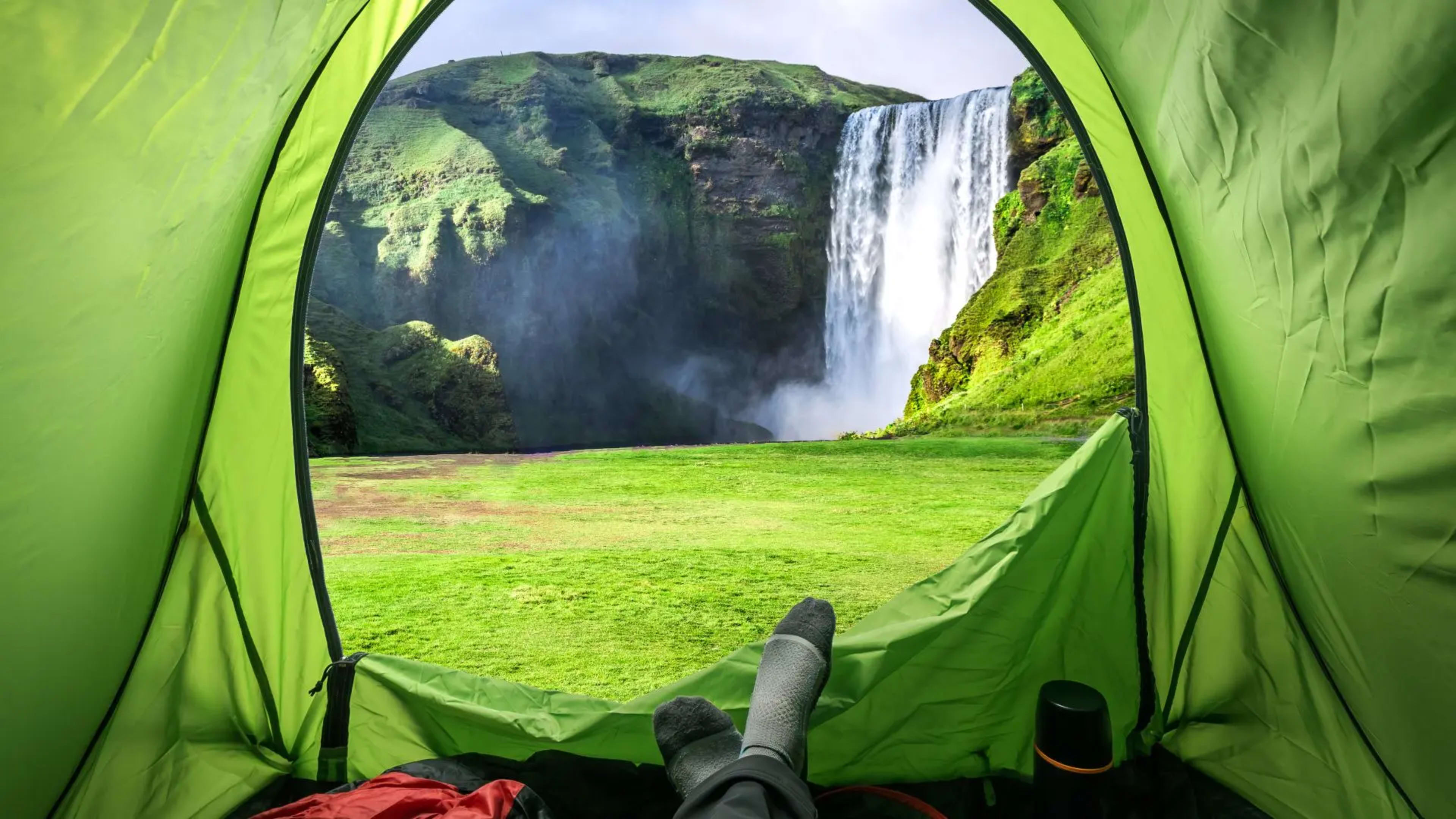Camping in Iceland is a fantastic way to get close to the country’s unspoiled nature without breaking the bank. And believe it or not, it’s possible to stay in a tent comfortably even this far north!
There are campsites spread all over the Icelandic countryside and most are open from April to September. These warmer summer months are popular with Icelanders too. You’ll see plenty of locals on holiday with their families at this time of year.
- Explore these Iceland camping trip itineraries.
So if you’re thinking of visiting Iceland in the summertime, why not go for something completely different and camp under the midnight sun? Read on to find out where to pitch your tent and to get useful camping tips for Iceland.
How to camp in Iceland

Your best bet is to stay at a designated campsite. Using the Ferðalag.is or Tjalda.is directories, you can easily locate one wherever you are in the country.
Most campsites have shared bathroom and cooking facilities, and some even have laundry facilities and Wi-Fi. This means you can stay clean, comfortable, and connected throughout your trip.
Of course, one of Iceland’s greatest appeals is its wilderness. If you choose to camp, you’ll enjoy endless unspoiled views and crisp, clean air. You might well be wondering if you can get this experience by staying on a campsite, and be thinking about wild camping instead.
What about wild camping in Iceland?

In 2015, rules in Iceland were changed on wild camping to help protect the country’s fragile ecosystem. Whilst not illegal on a national level, you’re required to get the landowner’s permission before pitching your tent.
- Find out more about Iceland’s precious nature and landscapes.
Wild camping is banned in national parks, like Þingvellir National Park and Vatnajökull National Park, and at many tourist sites. For a worry-free trip, we definitely recommend sticking to designated campsites.
The thing is, in Iceland, nature is never that far away. There are many remote campgrounds that let you get up close and personal with the local scenery. So compared to many other countries, campsites in Iceland can feel pretty wild!
10 of the best campsites in Iceland
It’s time for the lowdown on where to go camping in Iceland. We’ve narrowed down the dozens of campsites around the country to 10 of our favorites.
Pre-booking is generally not required. But bear in mind that in the summer, the more popular campsites can fill up quickly as Icelanders go on weekend breaks from the city.
Knowing that, it’s a good idea to try and make sure you get a pitch by the afternoon or early evening. It’s also worth having one or two backup options just in case your preferred campground is full.
1. Svínafell
Website: Svínafell Tourist Service
Location: Vatnajökull National Park, Southeast Iceland, off Route 1
Facilities: Tent pitches, toilets, showers, cooking facilities, laundry facilities
Open: Start of May to end of September
2. Hallormsstaðaskógur
Location: Atlavík and Höfðavík in Hallormsstaðaskógur forest, East Iceland
Facilities: Tent pitches, toilets, showers, washing-up facilities, outdoor barbecues
Open: End of May to start of September
3. Þingeyraroddi
Website: Þingeyraroddi Camping Ground
Location: Þingeyri, Westfjords
Facilities: Tent pitches, toilets, showers, cooking facilities, laundry facilities, swimming pool, café/restaurant
Open: All year
4. Reyðarfjörður
Location: Near the town of Reyðarfjörður, East Iceland
Facilities: Tent pitches, toilets, showers, laundry facilities
Open: Start of June to end of August
5. Borgarfjörður eystri
Location: Northeast Iceland
Facilities: Tent pitches, toilets, showers, cooking facilities, playground
Open: All year
6. Þórisstaðir
Location: West Iceland
Facilities: Tent pitches, toilets, cooking facilities
Open: All year
7. Varmahlíð
Website: Varmahlíð Camping Ground
Location: North Iceland, off Route 1
Facilities: Tent pitches, toilets, showers, hot tub, playground
Open: Mid-May to end of October
8. Vesturdalur
Website: Vesturdalur Camping Ground
Location: Vatnajökull National Park, Southeast Iceland
Facilities: Tent pitches, toilets, showers, laundry facilities
Open: Mid-June to mid-September
9. Vestmannaeyjar (Westman Islands)
Website: Vestmannaeyjar Camping Ground
Location: Westman Islands, South Iceland (ferry trip required)
Facilities: Tent pitches, toilets, showers, cooking facilities, laundry facilities, playground
Open: Start of May to end of September
10. Djúpivogur
Location: Southeast Iceland
Facilities: Tent pitches, toilets, showers, cooking facilities, Wi-Fi, playing field, laundry facilities
Open: All year round
Is the weather in Iceland suitable for camping?

Yes! The summer weather is normally warm and dry enough for camping. That said, Iceland is still pretty far north and in the middle of the North Atlantic. That means you should be prepared for different conditions, including wind and rain.
Even though summer days can be pretty warm, the heat quickly drops off in the evening. In August, one of the most popular months for camping, the average temperature is 11°C (52°F). This can drop to around 7–9°C (45–48°F) at nighttime.
- In our Travel Guide, you can learn more about Iceland’s weather and climate.
The amount of shelter you have will make a big difference to how cold you feel. If you’re near the coast, try and avoid pitching directly in the path of a sea breeze. You might want to go for a more sheltered campsite in this case.
What to pack for your Iceland camping trip
Sleeping in a tent in Iceland under the midnight sun can be a magical experience! But as with any camping trip, it pays to be prepared.
Of course, it doesn’t make sense to lug your own camping equipment with you from home. If you book a package from Iceland Tours, you’ll get the following gear included:
- Tent
- Sleeping bags
- Air mattress
- Cooking equipment and cutlery
- Camping stove
- Coolbox
There are lots of packing lists out there for camping in a tent, but we recommend bringing the following when staying on campsites in Iceland:
- Warm layers
- Thermal socks
- Flip-flops (for walking around the campsite)
- Swimming gear
- Mini flashlight
- Power pack for charging your devices
- Refillable water bottle
- Check out this handy packing list for Iceland.
Where to get supplies for your camping trip
You can stock up on food, toiletries, and other essentials at supermarkets around the country. The cheapest is generally Bónus, found in most larger towns.
Other Icelandic supermarkets include Krónan and Nettó, which generally have longer opening hours than Bónus.
In smaller towns and villages, you might find Krambúð or Samkaup Strax. These tend to be more expensive. And here, service stations are often the only place to get a hot meal (but they’re normally good value).
On the other hand, larger towns such as Borgarnes and Selfoss normally have a couple of restaurants.
In the countryside, vegan and vegetarian options can be limited, so it pays to bring your own food supplies just in case.
How to plan your camping trip in Iceland

There are hundreds of possible routes you could take on a camping trip around Iceland. But how do you choose the right one for you? And how will you get around?
Rental car or camper van?
Let’s talk transport. Renting a car makes the most sense if you plan on staying in a tent. Many campgrounds in Iceland are remote, and most of them aren’t near public transport links.
By car, you’ll also have ultimate freedom to explore Iceland’s fantastic nature and exciting attractions. You could tour the famous Ring Road, which takes you all the way around the country. Stop and start whenever you like, and take detours when you spot something cool.
Camper vans are also an option. They can be tricky to drive if you’re not used to Icelandic roads though. And they can sometimes get stranded in high winds, which are possible at any time of year. If you do decide to rent a campervan, we’d recommend a smaller vehicle.
If you’re not confident about driving a campervan, stick to a rental car and a tent.
Organizing your Iceland camping itinerary
Start by deciding what your must-sees and must-dos are for your Iceland trip. If the Northern Lights are on your list, then a summer trip is off the cards. The Aurora Borealis are only visible in dark winter skies.
- Northern Lights not negotiable? Explore these winter self-drive trips instead.
If you want to see hot springs and waterfalls, it makes sense to pick a route that includes the Golden Circle and south coast. With an itinerary that includes these areas, you’ll also get to see black sand beaches and Þingvellir (Thingvellir), the site of Iceland’s Viking-age parliament. You could pitch your tent at the campsite in the village of Vík.
Are glaciers and icebergs more your thing? You’ll want to pick a route that goes to Iceland’s southeast. There you can stop at Jökulsárlón glacier lagoon, which is full of icebergs even in summer. And you can check out Vatnajökull, the biggest glacier in Iceland. Here it makes sense to camp at Svínafell.
At Iceland Tours, we offer a range of camping itineraries, so you’re bound to find one that suits you. You’ll get a rental car and camping gear included. And with our Book with Confidence promise, you can change your dates or get a refund should your plans change.
Take a look at our Iceland camping tours today and start planning your ultimate outdoor adventure in the Land of Fire and Ice.



